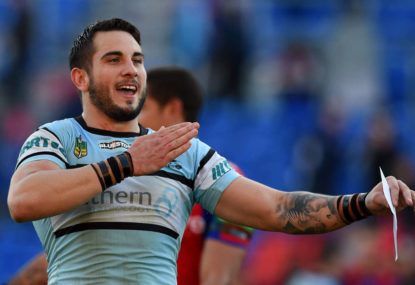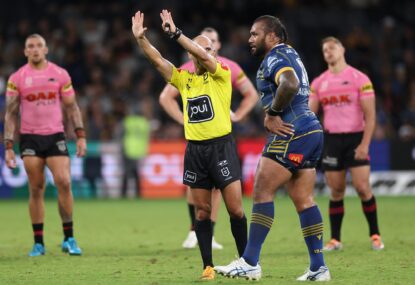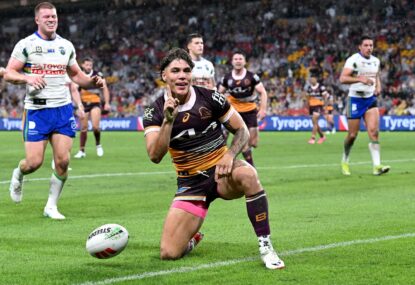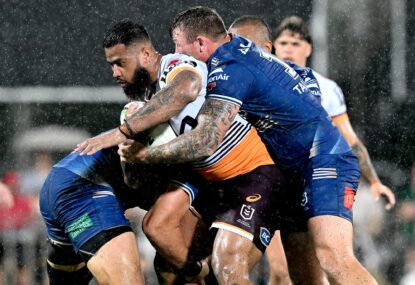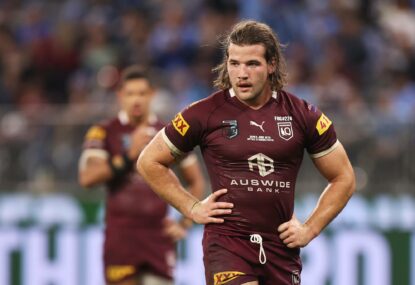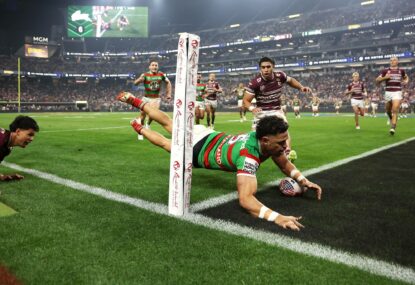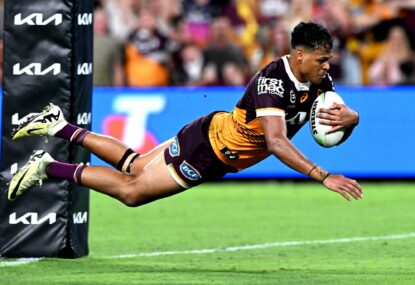With the 2016 NRL season fast approaching the experts are coming out with their predictions for the year. Many of these predictions are based on roster changes, draws and a hunch of how they think the upcoming season will unfold.
There is nothing wrong with these predictions. In fact time and time again the inclusion or removal of one player has completely altered the complexion of a season. Think the arrival of Sonny Bill Williams at the Roosters in 2013 or the departure of Sam Burgess last season.
But I decided to take a different look at this season. Instead of predicting a premiership winner, often a futile exercise, I took a look at which teams are likely to regress this season.
It is common knowledge throughout the American sports world that teams that make huge improvements in one season are likely to take a step backwards the following year. It doesn’t have to be a huge regression but more a correction of the team’s long-term trajectory.
There are so many different factors and variables contributing to a team’s performance that it is common for teams to unexpectedly over-perform. But it is rare that those breaks go a team’s way two years in a row. Thus, we see regression the year after over-performance.
Obviously there are exceptions to this rule, the return of LeBron James to the Cleveland Cavaliers completely altered the team’s long-term trajectory and the jump seen last season has been more or less sustained this year. But overall, the model holds true.
This sort of thinking has never really been applied to Australian sport before. Phrases like “a horrid injury toll” or “their season was ruined by a number of close losses” are often thrown around as reasons for a team’s poor performance a season after a year of significant growth.
But we tend not to look at what happened in previous years to see if that contributed to the team’s decline. Maybe that team won a number of close matches that they should have lost, or maybe they got lucky and played three understrength teams during the Origin period that artificially inflated the team’s win total.
So with that in mind, I decided to take a look back at the past 18 years of the NRL and discover if teams tended to regress following a big leap or if they were able to sustain the gains. If a pattern emerged, we would be able to take a look at the teams that improved significantly last season and investigate whether they will regress this season or prove the exception to the rule and continue their growth.
In my analysis I classified a significant improvement as that of an increase in wins by four games or more based on the previous year. Throughout the past 18 years, 47 teams have experienced this phenomenon. Of those 47, two occurred last season.
A further occurrence was the 1998-1999 South Sydney Rabbitohs, who were kicked out of the competition in 2000, thus we do not have the stats for how they backed up the improvements they made in 1999.
Finally, the Melbourne Storm made a significant improvement from 2010 to 2011. However, the team did not play for any competition points for much of the 2010 season as part of their punishment for breaching the salary cap. As a result, I have decided not to include this improvement in my analysis because their results in 2010 were so heavily influenced by external factors.
Thus, we have 43 instances in which we have a full three-year sample.
Of those 43 teams, nine improved in that third season, one team had the same record and the remaining 33 regressed. The average performance of those 43 teams in the third season was a decrease of three wins based on the previous year.
We are able to dig down further and find that of the 33 that saw their performance decline, six were by just one or two losses. These teams remained fairly consistent from year to year and were effectively able to maintain the play that saw them make such a leap in the first place.
If we are going to use this data to make a judgement on the two teams who improved by four or more wins last season it is important to know why teams have been able to maintain this level of play.
For those wondering, the two teams in question this year are the Brisbane Broncos and Cronulla-Sutherland Sharks.
If we take a look at the nine teams that have displayed improvement after a large jump, two of them have seen their results in one of those seasons stripped due to salary cap breaches. Those teams are the 2002 Bulldogs and 2007 Storm. So some element of that success can be directly attributed to cheating and the benefits of keeping together a roster that was effectively being paid more than every other team.
The vast majority of our remaining seven teams saw significant improvement arising from the arrival of a new coach. This coach was able to immediately turn their new team’s fortunes around and ensured that they stayed at this high level. Michael Maguire’s arrival at South Sydney in 2012 is one such example.
Alternatively, the arrival of a star player, or players, was able to significantly and sustainably improve a team. We can see this through the 2011-13 Cronulla Sharks. Shane Flanagan arrived at the club in 2011, a season in which the team struggled, finishing with a 7-17 win-loss record.
2012 saw the arrival of a number of new recruits, including Todd Carney, Andrew Fifita, Bryce Gibbs, Isaac De Gois, Ben Ross and Sam Tagataese. The arrival of these players along with a continued familiarity with Flanagan’s system saw the team improve quite significantly. As such, the team was able to improve upon their 2012 season because the growth occurred naturally. It occurred because a new coach changed the direction of the club and recruited players that he knew would fit his system.
Overall, the instances in which a team was able to sustain their improvement occurred when a team was transitioning from good to great. The teams that struggled to keep improving, such as the 2013-15 Panthers, were those that went from average to great in the space of a year.
So there are instances in which a team can back up their significant improvement with continued growth. But are our two teams candidates for growth this season?
Let’s start with the Brisbane Broncos. Fortunately for Broncos fans, their improvement last season fits the mold of a number of different successful categories.
Firstly, last year saw the arrival of a new coach, Wayne Bennett, a man with the ability to completely shift a team’s fortunes. Secondly, the Broncos also signed a new half last year in the form of Anthony Milford. Milford defied expectations and starred for the Brisbane-based side, playing a major role in the team’s run to the grand final.
However, there are plenty of examples over the past 18 years of teams that have experienced similar circumstances and failed to match their win-loss record in the following year. The most recent example would be the 2012-2014 Roosters.
The Roosters struggled in 2012, winning just eight matches. The end of 2012 saw the departure of coach Brian Smith, with Trent Robinson arriving in 2013. The phenomenal Sonny Bill Williams joined Robinson in Bondi and instantly the Roosters were a Premiership contender.
The Roosters won the Premiership in 2013 after winning 18 matches in the regular season. However throughout 2014 the team struggled to match the performance of the previous year. They remained a very good football side, winning 16 matches, but to an external observer it was very clear that in comparison to the rest of the competition, the Roosters had regressed.
So what will happen to the Broncos in 2016? Unlike the Roosters, the Broncos were not a bad football team in 2014. Instead, they were average, winning 12 of their 24 matches. Thus, the jump they made in 2015 was smaller and more sustainable.
However, it is very rare in the current salary cap era that a team is able to back up a 17-win season with another 17 or even an 18-win season. The odds of Brisbane improving on last season and winning 18 or more games this year are quite low.
That is not to say that they won’t be a contender, in fact it is probable that they will finish in the top four on the ladder. Do not expect the Broncos to slump quite like the Panthers did last year after a top-four finish in 2014. Instead, the Broncos will likely regress slightly this year, in a similar manner to the 2014 Roosters, ultimately winning around 15 matches.
The Cronulla Sharks are a very intriguing proposition. Their 2014 season was torn apart by the ASADA peptides sage. Their coach was suspended for the entire season, the athletes played three-quarters of the season with a cloud hanging over their heads before ultimately submitting to what was effectively a three-game suspension to close out the season. On top of this, they sacked Todd Carney mid-season after he failed to behave off the field while Andrew Fifita suffered from injuries, poor form, off-field misbehaviour and mental health troubles.
A perfect storm of factors contributed to the Cronulla Sharks season from hell and ultimately resulted in a five-win season.
It was expected that the team would bounce back in significant fashion last season. And bounce back they did, winning 14 of their 24 matches. If you ignore the 2014 season, this represents the Sharks long-term growth trend under Flanagan. As mentioned previously, the team won 14 games in 2013 as well.
Unsurprisingly, we have seen this happen before. A team suffers one season aberration before promptly bouncing back as if that season never happened. In 2009 and 2010 the Titans won 16 matches, however, they followed these two seasons by winning just six games in 2011. While not returning to their 2010 level, they did bounce back by winning ten matches in 2012 and eleven in 2013.
The Sharks rise in 2015 was buoyed by the emergence of a number of promising youngsters, including Jack Bird and Valentine Holmes. These two players have the potential to develop into stars of the game and may one day lead the Sharks to the Promised Land.
However, both Bird and Holmes have found themselves in uncharted territory this season. Bird emerged as a long-term five-eighth last season after the Sharks signed former Roosters half James Maloney. With Maloney arriving in the Shire, Bird has been shunted out of the six jersey.
At this stage, the Sharks appear set to throw Bird into the fullback position. This means that Holmes will return to the wing, the position where he made his debut back in 2014. However, the Sharks have another fullback on their roster in the form of Ben Barba. After struggling last season, Barba looked to be in promising form during last weekend’s All-Star match and will be looking to reclaim his place in the starting line-up.
Overall, these are positive problems for a coach to have to deal with. However, if Flanagan can’t integrate all his stars into the team in positions where they are able to contribute, the Sharks may struggle. But if the team clicks from the get-go, the Sharks will push for the top four.
The Sharks are a promising team with a lot of upside. Should they avoid the injury bug they will more than likely buck the trend and improve upon last season’s total of 14 wins.






























































































